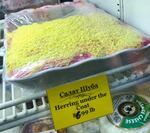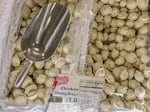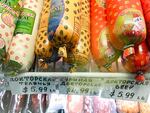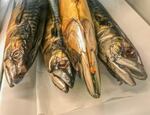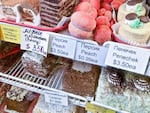Page after page, "Kachka: A Return to Russian Cooking" by Bonnie Frumkin Morales pops with orange and blue.
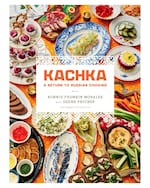
“Kachka: A Return to Russian Cooking” by Portland restaurateur Bonnie Frumkin Morales is a smart, delicious read, the tale of a Belarusian family's move to the U.S., a daughter's discovery and playful reinterpretation of culinary traditions — and there are recipes!
A.J. Meeker / Courtesy of Flatiron Books
When she and photographer Leela Cyd were styling the food, “I was bringing in bins and crates of hoarded family members' linens, plates, bowls — enamelware,” said Morales, chef/owner of Portland’s acclaimed Russian restaurant Kachka. "My iconic bowl is orange with white polka dots. I grew up with those bowls.”
Morales is American-born but her parents moved to the Chicago area from what had been — and would be again — Belarus. The almost-400-page book, written with Portlander Deena Prichep, is "a very personal glimpse of the food of my childhood, very specifically Russia and the former Soviet Union, which covers huge swaths of land with a dozen time zones or more."
OK, she didn't always love the food. “Growing up, I pushed it as far away as I could,” Morales said. Later, after trying to use her culinary-school skills to "fix" these neglected cuisines, she realized they weren't "broken" after all.
The book's recipes include cocktails, pickles, dumplings, soups, the mangal (think Russian grill), homestyle dishes and desserts. But the zakuski rule. "I used for a template the way dinner is done at my parents' house," said Morales. "Eighty percent of mealtime is spent eating zakuski" – warm and cold appetizers that crowd the table – and drinking. "You graze, hang out, develop a cadence. It's not just about eating what's on a plate in front of you."
Related: 'The Four Top': Bonnie Frumkin Morales | Deena Prichep | Michael Zusman
"What's in the glass is not important. My son has apple juice in his shot glass and my grandmother has sweet wine. It's the concept of toasting and drinking together, in unison, for a reason." Morales said no one stands around with cocktails. "That would be a faux pas. To just drink is weird, strange — only alcoholics do it."
After this leisurely ritual, traditionally "the men go outside to smoke and the women reset the table with the warm main dish." Dessert follows and no one would think of leaving before tea is served.
Her disclaimer in the book: While some recipes "are (almost) straight from my mother's smudged and stained files," others "feature the results of my own deliciously inauthentic tinkering with ingredients of the region. ..."
The book is studded with fun, fact-filled graphics, including guides to the Russian market and stocking the pantry; things wrapped in dough; demystifying caviar; babushka's remedies; MacGyvering the mangal; tea culture; and those shiny wrapped candies. It took "three years with two of us writing," she said. "It's more than a cookbook, like Kachka is more than a restaurant. We take people on a journey."
Home cooks in the Portland metro area have "tons of resources because of its massive Russian population," Morales said, "one of largest per capita in the country." The east side — Vancouver to Gresham — is more Russian Orthodox, she said, while Russian Jews have tended to settle on the west side. She recommends Imperial Euro Market (where photos for the book were taken) and Roman Russian Market, both east of Interstate 205.

Aysha Iznurova works at Roman Russian Market’s deli counter, stocked with cured meats like salamis and sausages.
Jo Mancuso / OPB
"I like to work seasonally and we have amazing produce here. Hunting for mushrooms, like chanterelles, is part of the Russian psyche, like in the Northwest. And here they might be $7 a pound around Thanksgiving, not $40, like elsewhere."
Morales said she and her husband, Israel, expect an April opening for their second, larger inner-Southeast eatery, which will feature an expanded menu, deli space and year-round mangal station. It will assume the Kachka moniker, while the original venue — renamed Kachinka — will become a more casual "happy-hour all-the-time lounge" with a smaller menu.
Morales will be demonstrating grain-based dishes from the book in a class (paid preregistration required) at Bob's Red Mill in Milwaukie on Jan. 12. She and Prichep will be at Powell's Books at 7:30 p.m. on Jan. 19.
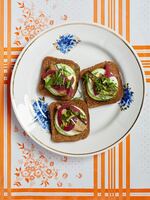
Sprat Buterbrodi is a cold Soviet zakuska, one of countless warm and cold home-style appetizers you'll find crowded onto a table for the leisurely ritual of eating, drinking and toasting that precedes the main Russian family meal.
Leela Cyd / Courtesy of Flatiron Books
Sprat Buterbrodi [бутербродики со шпротами]
"What I am about to share might start a family feud: I credit these little party-sized fish, egg, and mayo toasts to my aunt Asya — they've been a staple in her zakuski rotation for decades. This is known. My mother, as far back as I can remember, never made them. That is until my mother noticed the gusto with which my now-husband-then-boyfriend enjoyed Asya's buterbrodi (this was back when he was still new to the family, and everyone was trying to win him over with food). Sure enough, they started appearing on my mom's zakuski table. And not only appearing — my mother maintained, vehemently, that they were her recipe from the outset, and Asya stole them from her.
"Far be it from me to get between two Soviet women and their signature zakuska. But the joke in all of this is that sprat buterbrodi are a bit of an archetypal dish — like B.L.T.s, or bagels with lox and cream cheese. Although, of course, I've made a few tweaks to the standard combination (whoever's it may be)." — Bonnie Frumkin Morales
Prep: 30 minutes (excluding hard-boiled eggs, smetana butter and parsley mayonnaise) | Easy
Makes 12 small toasts
Ingredients
Pickled Onions
- 1/2 large onion, sliced into 1/8-inch thick half-moons
- 1/2 cup red wine
- 1/4 cup distilled white vinegar
- 1/4 cup apple cider vinegar
- 1 tablespoon kosher salt
- 2 teaspoons granulated sugar
Toasts
- 12 slices pumpernickel cocktail bread (Rubschlager brand, if available)
- 1/3 cup smetana butter (see recipe below) or cultured European-style salted butter, softened to room temperature
Herb salad
- 2 tablespoons dill sprigs, torn or picked into feathery fronds
- 2 tablespoons radish sprouts (optional)
- 2 tablespoons parsley leaves (use the smallest leaves available)
- 2 tablespoons chives, sliced into 1-inch batons
- 1 teaspoon refined sunflower or olive oil
- Kosher salt
To finish
- 1/2 cup parsley mayonnaise*
- 3 large hard-boiled eggs
- 12 smoked sprats, drained (Riga Gold brand, if available) (about half of 1 jar/tin)
*Use homemade (see recipe below) or commercial mayo
To prepare
Make the pickled onions: Place the onions in a heatproof bowl. Pour the wine, vinegars, salt, and sugar into a small saucepan, and bring to a boil (run the fan — hot vinegar packs a punch). Remove from heat, and pour over the onions. Let the mixture cool to room temperature, then use, or refrigerate for up to 1 week.
Make the pumpernickel toasts: Generously spread the bread with butter on both sides. Heat a griddle or skillet over medium heat, and toast the bread for a few minutes, until it starts to darken (but not burn — adjust heat as needed). When the first side is toasted, flip it over, and cook the second side. Remove from the pan when the toasts are crunchy on the outside but slightly soft in the middle, and set aside. Toasts can be made 1 to 2 hours in advance — if you need to make them much farther in advance, toast the bread a few minutes more, until it's crisp throughout (it'll keep better).
Shortly before serving, make the herb salad: Mix together the dill, radish sprouts (if using), parsley, chives, oil, and salt. Be gentle — the herbs are delicate!
To assemble: Place the toasts on a serving plate, and top each one with a spoonful of the parsley mayo. Using an egg slicer or a sharp knife, slice the eggs, and top each blob of mayo with an egg slice (leftover egg whites and yolks can be used to garnish Herring Under a Fur Coat or Salat Mimoza). Press down gently on each egg slice, so that the mayo spreads beneath it to form a nice egg-framing halo. Top each toast with a sprat, a few slices of pickled onion, and a generous pinch of herb salad. Serve.
Smetana [Сметана]
"Obligatory Dairy Nerd Rant: Smetana means "sour cream." But all too often, commercially produced so-called sour cream in the United States is actually not sour cream! It’s made with a fraction of the butterfat that it needs, and is not cultured (the “sour” in sour cream). Instead, thickeners and acids are added to give an approximation of the body and tartness that would come naturally if it were truly cultured full cream.
"Where I come from, smetana is kind of a big deal. It's the mother sauce of Mother Russia. Used as a braising liquid, a salad dressing, rubbed on roasts, mixed into soups — you name it. At Kachka, we go through gallons of the stuff every week. Luckily, making it yourself takes nothing more than two ingredients and a couple of days of waiting." — Bonnie Frumkin Morales
Hands-on prep: 30 seconds | Very easy
1 quart
Ingredients
- 1 quart heavy cream
- 1/8 teaspoon 901 Buttermilk & Sour Cream Culture* or 1/4 cup buttermilk
- *Available online at www.getculture.com.
To prepare
Bring the heavy cream to room temperature, and mix it with the culture or buttermilk. Let the mixture sit out at room temperature, loosely covered, for 12 hours. Transfer the container to the refrigerator for 12 hours, then return to room temperature to finish, 10 to 18 hours, depending upon the temperature—it’s done when it has thickened. Store in the refrigerator.
Smetana Butter [масло на сметане]
"If you've ever overwhipped cream before, then you've basically made butter — it's just that easy. Using smetana instead of cream adds a tangy complexity to butter's richness that's totally addictive. Spread it thickly on your preferred bread (brown or otherwise) for a life's-simple-pleasures kind of moment." – Bonnie Frumkin Morales
Prep: 30 minutes | Easy (kids can do it)
About 2 cups
Ingredients
- Smetana (above)
- Kosher salt
To prepare
- To churn this into deliciously rich cultured butter, use smetana that has been properly chilled in the refrigerator overnight. Transfer the smetana to the bowl of a stand mixer fitted with a whisk attachment, and use a splash guard if you've got one (or else be prepared for a bit of spatter). Whisk on high speed, past the point of whipped cream, until the mixture clumps around your whisk, and a pool of liquid separates out at the bottom. You can't overmix, so don't hold back.
- Strain off the liquid (which is actual buttermilk) through a fine-mesh strainer. Transfer the curds to a bowl, add cold water to cover, and knead the mixture until it comes together and the additional buttermilk comes out—this creates a more refrigerator-stable no-spatter product, but if you're just using it as-is/right away you can skip this step. Transfer the butter mass to a paper towel and blot any excess liquid. Sprinkle salt all over and knead (or mix in a bowl with a spoon) to incorporate.
Mayonnaise [майонез]
"It is impossible to overstate the Russian obsession with mayonnaise. The Soviet state really pushed mayo, and was beyond successful — you find it everywhere. It’s even used à la frosting, piped into florets and flourishes on unassuming salads and whole fish presentations (in a fashion you may have thought disappeared in the 1970s).
"As a proper American kid, I hated the stuff myself. It didn’t really matter whether it was the beloved Provansal style of the Soviet era or Hellmann’s — it was all the same gloppy white stuff to me. It wasn’t until I went to culinary school that I had a revelation — mayo doesn’t have to be this terrifying, jiggly refrigerator staple. It’s just a sauce. Yolks, oil, water, and a bit of lemon. Make mayo yourself (spoiler alert: it’s surprisingly easy), and it’s like meeting a whole new condiment — one you might be inspired to consume in near-Russian amounts." — Bonnie Frumkin Morales
Prep: About 15 minutes | Advanced for the novice; super easy once you know how
About 2 cups
Ingredients
- 2 large egg yolks (if you're worried about consuming raw eggs, you can use pasteurized)
- 1 tablespoon dijon mustard
- Juice of 1/2 lemon
- Kosher salt
- 2 cups refined sunflower oil (or any fresh, high-quality neutral oil)
- Up to 1/2 cup water
To prepare
Grab a large bowl (glass or stainless steel), and place it on a damp towel to keep it still as you whisk, whisk, whisk. Whisk together the yolks, mustard, lemon juice, and a good pinch of salt. Slowly whisk in the oil — a few drops at first (I find a squeeze bottle particularly handy for this), and then a bit more of a stream once things come together. If the mixture tightens up too much before you’ve added all the oil, add some water (a spoonful or two at a time) to loosen it, up to 1/2 cup (you likely won’t need that much). Keep adding oil (and water, if needed) until it’s all incorporated. Taste and add salt as needed.
Mayonnaise is best used the same day it is made, but can be kept for 2 days in the refrigerator (longer if using pasteurized eggs).
Parsley Mayonnaise [майонез с петрушкой]
Prep: 5 minutes | Easy
Ingredients
- 1/2 cup mayonnaise (homemade or commercial)
- 1/2 cup parsley, finely minced
- 1 small clove garlic, finely minced
- 1 tablespoon fresh lemon juice
To prepare
In a bowl or food processor, mix together all of the ingredients until combined.
Excerpted from “Kachka: A Return to Russian Cooking,” copyright 2017 by Bonnie Frumkin Morales. Republished with permission from Flatiron Books.


